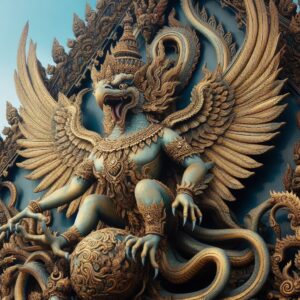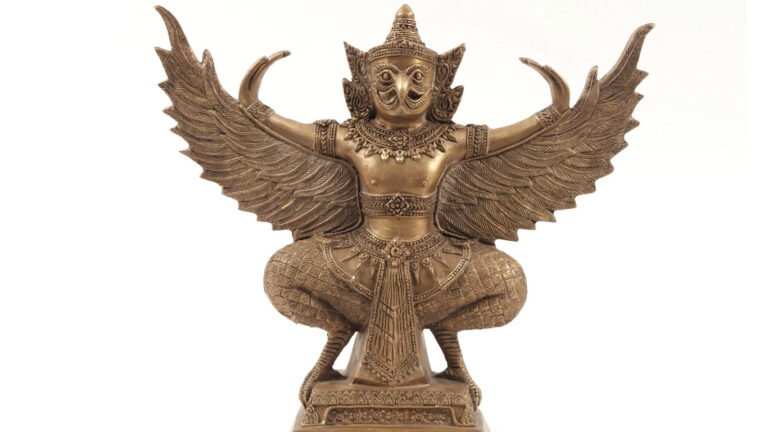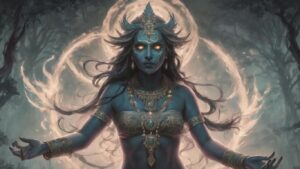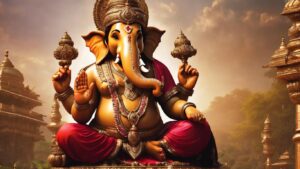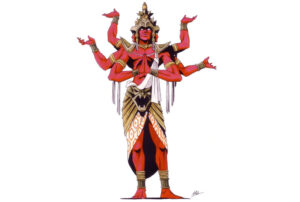Table of Contents
Garuda, a mythical eagle in Hinduism, plays a vital role in Hindu mythology. Revered as Vishnu’s mount, Garuda symbolizes strength and loyalty. With a majestic appearance characterized by wings, beak, and talons, Garuda is a powerful and revered creature. In various myths, Garuda showcases incredible speed and the ability to soar through the skies. Notably, he is immortal and possesses healing powers, making him a unique and multifaceted figure. Garuda’s significance extends beyond Hinduism, influencing Buddhist and Jain traditions. Beyond ancient texts, Garuda continues to captivate modern audiences through art, literature, and popular culture.
Mythological Origins

In ancient Hindu mythology, Garuda, a majestic bird, embodies power and strength. Born to Kashyapa and Vinata, Garuda’s wings shimmered with divine brilliance. Blessed with incredible speed, he soared across the heavens, capturing the attention of gods and demons alike. Driven by a fierce determination to free his mother from servitude, Garuda embarked on a perilous journey. Swiftly, he confronted serpent deities, their venomous fangs poised for battle. Undeterred, Garuda outwitted them with cunning and agility, earning the admiration of all. Moreover, his unwavering devotion to Lord Vishnu garnered divine favor, making him a symbol of loyalty and triumph. In the tapestry of Hindu cosmology, Garuda remains a revered figure, a testament to the enduring power of myth.
In Hindu mythology, Haruda’s family centers around his parents, Kashyapa and Vinata. Born alongside siblings like Aruna, Haruda embodies divine strength. Transitioning to his connection with Lord Vishnu, Haruda serves as Vishnu’s devoted mount. The familial bond is integral, showcasing loyalty and shared destinies. In various narratives, Haruda’s family dynamics intertwine with the rich tapestry of Hindu cosmology, symbolizing power and devotion.
Physical Characteristics
Haruda, a mythical figure in Hindu lore, boasts a majestic appearance with wings that shimmer brilliantly. His formidable stature commands attention, symbolizing power and grace. Transitioning to his avian form, Haruda is often depicted as a magnificent eagle, radiating divine energy. The sharpness of his beak and talons reflects his prowess in battles against serpentine adversaries. Despite his awe-inspiring presence, Haruda’s countenance carries a sense of devotion, particularly when in service as Lord Vishnu’s loyal mount. In the intricate tapestry of Hindu iconography, Haruda’s appearance becomes a visual testament to strength, beauty, and spiritual significance.
Haruda’s symbols encapsulate divine attributes. His wings symbolize transcendence, while the eagle form signifies strength and freedom. Transitioning to his association with Lord Vishnu, Haruda’s symbols extend to the Sudarshana Chakra, embodying cosmic order. These symbolic elements intertwine seamlessly, representing Haruda’s multifaceted significance in Hindu mythology.
Key Attributes and Abilities
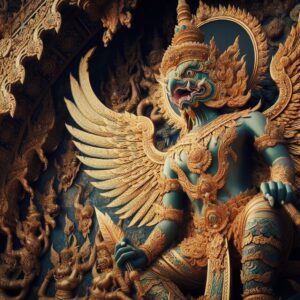
Garuda’s exceptional powers epitomize strength and speed, his wings a radiant spectacle of divine agility. Transitioning to his immortal nature, Garuda’s resilience and rapid healing set him apart in battles. The flames of his being not only incinerated foes but also symbolized purification. As a celestial being, Garuda possessed the unique ability to rejuvenate, emerging unscathed from the fiercest conflicts. His extraordinary attributes made him an embodiment of both power and vitality.
Garuda’s role as Lord Vishnu’s mount added to his significance. The Sudarshana Chakra, a cosmic disc, whirled in his grasp, signifying the divine order. Transitioning to the battlefield, Garuda’s presence was awe-inspiring, his talons capable of subduing even the most formidable adversaries. The bond with Vishnu elevated his purpose, aligning their destinies in the cosmic drama. In the grand tapestry of Hindu mythology, Garuda’s special powers and unique role as Vishnu’s mount make him an enduring symbol of strength, swiftness, and divine allegiance.
Mythical Stories and Legends
Role in Hindu Epics
In the vast expanse of Hindu epics, Garuda plays a pivotal role as Lord Vishnu’s revered mount. Transitioning to the Mahabharata, Garuda’s feathers adorned Arjuna’s chariot, symbolizing divine protection. Amidst the cosmic churn in the Puranas, Garuda’s might and speed facilitated the retrieval of the elixir of immortality. His wings, a radiant spectacle, shielded the gods and carried them across celestial realms. Transitioning to the Ramayana, Garuda’s presence graced the saga, emphasizing his eternal role in the Hindu narrative. In battles against powerful adversaries, his talons and fiery prowess exemplified unwavering loyalty and unmatched strength. The resonance of Garuda’s role echoes through the scriptures, weaving a timeless narrative of divine allegiance and cosmic significance.
Adventures and Interactions with Deities
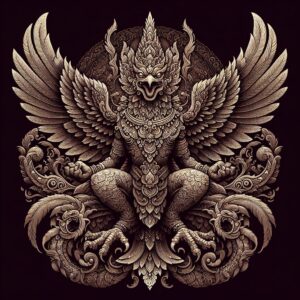
In the realm of Hindu mythology, Garuda embarks on daring adventures, his wings carrying him across celestial domains. Transitioning to encounters with deities, Garuda’s loyalty to Lord Vishnu is unwavering. He engages in cosmic quests, interacting with gods and goddesses, his presence commanding reverence. Amidst celestial battles, Garuda’s interactions showcase his valor, a testament to his divine lineage. Transitioning to his role as the vehicle of Vishnu, Garuda forges connections with other deities, embodying a bridge between celestial realms. His adventures unfold as intricate threads, weaving a tapestry of divine narratives and eternal alliances.
Cultural Significance
In Hindu rituals, Garuda holds a sacred place, his presence symbolizing protection and divine blessings. Transitioning to festivals, especially Garuda Panchami, devotees worship him fervently. Amidst elaborate ceremonies, offerings of flowers and prayers honor Garuda’s significance. Transitioning to processions, images of Garuda adorn vibrant celebrations, reflecting his revered status. Garuda’s role extends beyond mythology; he becomes a living deity in the hearts of worshippers during these sacred observances. The resonance of his presence in rituals and festivals echoes through the tapestry of Hindu spirituality.
Garuda’s influence on art is profound, his majestic form inspiring intricate sculptures and vibrant paintings. Transitioning to iconography, temples prominently feature his divine image, symbolizing protection and devotion. Amidst artistic expressions, Garuda’s wings spread across murals, conveying a sense of divine grace. Transitioning to symbolism, the Sudarshana Chakra, held by him, becomes an emblem of cosmic order. The interplay of artistic interpretations captures Garuda’s essence, immortalizing his significance in the visual narratives of Hindu culture.
Garuda Beyond Hinduism
Garuda’s presence extends beyond Hinduism into Buddhism and Jainism, symbolizing universal virtues. Transitioning to Buddhist art, Garuda appears as a revered figure, embodying enlightenment and wisdom. In Jain traditions, his symbolism aligns with non-violence and spiritual conquest. Transitioning to shared narratives, Garuda’s encounters with other deities transcend religious boundaries, illustrating a universal reverence for his virtues. The seamless integration of Garuda into diverse religious landscapes reflects his enduring significance and transcendence across cultural boundaries.
Modern Representations
